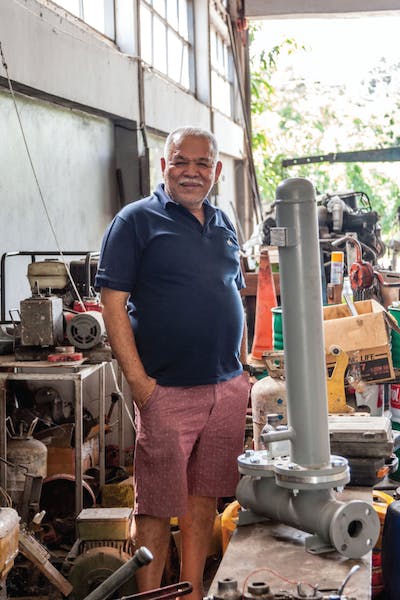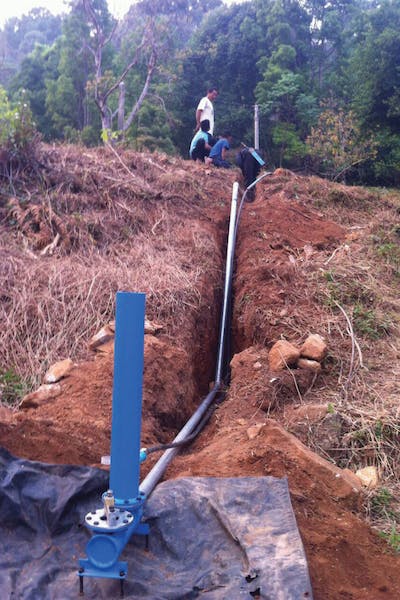“The important thing is that we must have water to drink, to use and to cultivate because life is there. If there is water, we can survive. If there is no electricity, we can also survive. But if there is electricity but no water, we cannot survive,” said His Majesty the late King Bhumibol Adulyadej in 1986.
The Visionary, a book by a project called Fulfilling Father’s Legacy, revealed that there were a total of 4,685 projects under the royal initiative throughout the 70 years of King Rama IX’s reign. Over 2,000 of those projects involved the management of water.
According to the Thailand Sustainable Development Sourcebook (second edition), water is much more than just a natural resource to Thai people. “It is integral to the lifeblood of our culture, coursing through the New Year Celebrations in April when Buddha images are washed and revellers doused, at festivals such as Loy Krathong where offerings are made to the Goddess of Water, in wedding rituals such as the anointment of couples’ hands by guests, or through bathing ceremonies performed on bodies before cremations”. As a country once dominated by agriculture and still dependent on it for food and income, water is a life-line that can make all the difference. According to the Hydro and Agro Informatics Institute (HAII) under the Ministry of Science and Technology, only one-sixth of the country’s farmland is irrigated.

“The vast majority of that lush farmland is in the central region, famous as the country’s rice bowl. Meanwhile, farmers in other parts of country — where rainfall can be unreliable, waterways non-existent and irrigation systems rare — face the regular threat of drought and must rely on whatever strategies they can devise to eke out a living. For decades, successive governments have advised farmers in these drought-prone areas to diversify away from water-intensive crops,” explained the Sourcebook.
During a royal visit to the North Eastern provinces of Thailand in 1955, His Majesty the late King first expressed his concern about water resource management after witnessing extreme poverty and learning that much of it was due to farmers’ lack of consistent access to water. “I have thought about this seemingly paradoxical problem: when there is water, there is too much, it floods the area; when the water recedes, it is drought,” wrote King Bhumibol in his journal afterwards. That very same year he began to conduct research into what would become the Royal Rainmaking Project with the Office of the Royal Development Projects Board (ORDPB). Over the years, His Majesty initiated and supported an array of water management resource research and development projects ranging from his nation-wide Monkey Cheek project to store water for less rainy days, to his check-dam initiatives and his numerous irrigation projects.
Poompat Tatiwattanachaikol or Uncle Poom, 62, has been farming his fruit orchard with his wife in Mae Taeng for 40 years. The problem with his land is that it is higher than the water source which has cost him as much as 4,000 baht each month to irrigate. His pumps require huge amounts of feul and are constantly breaking down due to the strain of pumping uphill. After years of research and testing, he found himself struggling to find a solution to suit him until one day he happened upon a book at the Chiang Mai University Library.
“I found everything I needed to know about the perfect pump for me in one book,” said Uncle Poom. “To my surprise, it was one of the royal initiated machines of King Bhumibol from back in the late 1970s. It was a design based on a hydraulic ram pump first designed over two centuries ago in the United Kingdom. His Majesty had heard about this pump and tasked engineers with developing it to suit Thailand. This pump is water powered.”

The hydraulic ram, or papa pump as it’s called in the UK, is a cyclic water pump powered by hydropower. The pump uses the water hammer effect to develop pressure that allows a portion of the input water that powers the pump to be lifted to a point higher than where the water originates. This pump is ideal for remote areas as the ram requires no outside source of power other than the kinetic energy of flowing water.
“It can pump water from the source to any area 10 to 15 times higher than the system,” beamed Uncle Poom. “However, about 10 to 15 percent of water is likely to be wasted which makes this suitable for smaller movements of water, such as households or small farms.” An added benefit of this pump is that enough power is generated from it to run a fridge, or around 800 watts!
The most attractive thing about this pump is that it is cheap. “The first ever ram pump I built at our farm has yet to break, as have none of the ones I have installed elsewhere,” added Uncle Poom who has spent years helping farmers throughout the north of Thailand to install this pump.
“The cost to install a ram pump is about 40,000 baht which is very little when considering it lasts for many years and has no operational costs. This pump is also mobile and can be shared amongst many farmers which drastically reduces the cost to any one farmer. When you see government officials spending millions of baht on their pumps, I wonder why they don’t use this,” said Uncle Poom. He added “I am still doing research on the pump and hopefully it will become more effective in the future.” Even if Uncle Poom doesn’t achieve his goal, his children have been inspired by his work and are now both engineers, able to take on the mantle.
As we remember the birthdate of our late King this month on December 5th, we celebrate a tiny and mostly unknown part of His Majesty’s legacy. HM’s lifework was first and foremost about people-centred sustainability and this is a prime example of a small facet of his incredible body of work.
